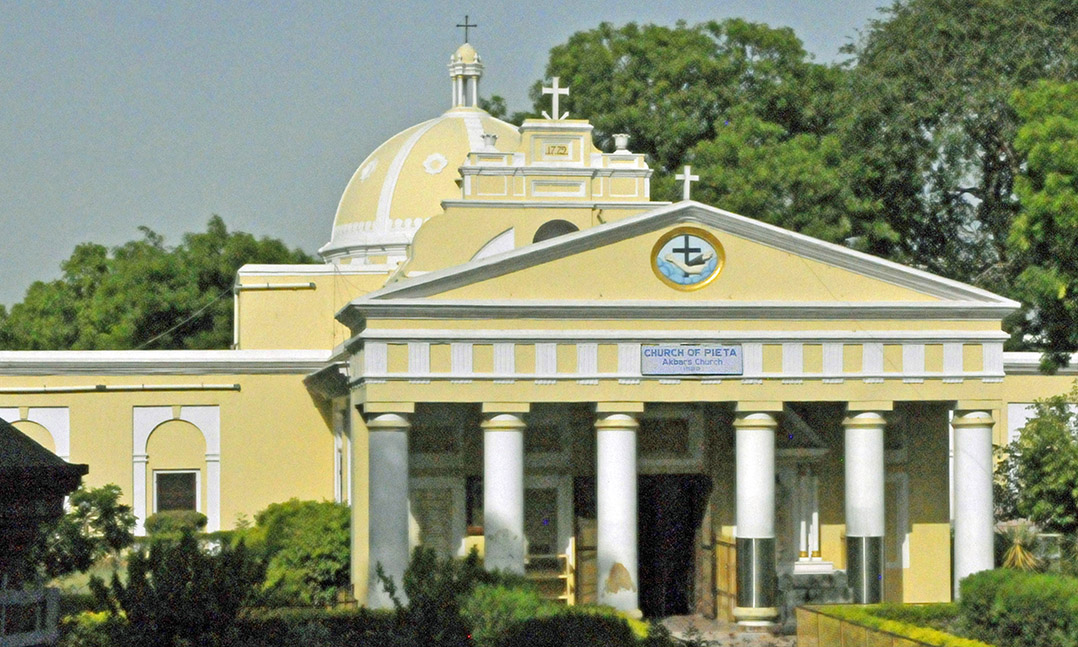THE CHURCH OF PIETA (Akbar's Church)

Akbar's Church built in 1599 was the first Catholic Church of Agra and it was the Cathedral of Agra
till 1848. The Church was built by the Jesuit Fathers under Akbar's order. It was a gift from the
Mughal Emperor Akbar. In this Church the Mughal Emperors came to pray, especially Jahangir. Emperor
Jahangir finding the Church built by his father, Akbar too small, donated a large sum of money for
a larger and more beautiful Church to be built.
Two eminent Catholics, Khwaja Martins and Mirza Sikandar Junior contributed generously towards the
extension of this Church.
In 1632 Emperor Shah Jahan declared war on the Portuguese. He defeated them in 1634. He brought
over 4000 prisoners to Agra, all Christians. They underwent persecution and so did the Jesuit
Fathers. In 1635 Shah Jahan released the Jesuit Fathers on condition that they pulled down their
Church. This was done. However in 1636 the Emperor allowed the Fathers to rebuild the Church
with the material of the ruined Church. On September 8, 1636, the reconstruction was completed
and celebration of Holy Mass was resumed thereafter. It underwent great changes during in the
course of the next two centuries.
In 1758 the Persian Invasion under Ahmed Shah Abdali shattered the Mughal supremacy. During the
siege of Agra, the Church was ransacked by the Persian soldiers.
In 1769 Walter Reinhardt, then Commander of Agra Fort, helped Fr. Xavier Wendel S.J. to rebuild the
Church and make an extension. In 1835, Bishop Pezzoni with the generous aid from Sir John Baptist
Filose, extended the Church westward.
This Church has witnessed many a historical event. In 1610, three Royal Princes, nephews of the
Emperor Jahangir, were baptized by Rev. Fr. Corsi, S.J. and Fr. Xavier S.J. It was here, the Begum
Johana Sumroo, the Begum of Sardhana, was baptized. It was in this Cathedral, the Religious of
Jesus and Mary Sisters from France were solemnly received by Bishop Borghi on Sunday, November
13, 1842. It was the proud privilege of Bishop Borghi to consecrate in this historic Church,
Msgr. Carli, Bishop of Almira in 1843 and the Servant of God, Bishop Anastasius Hartmann,
Vicar Apostolic of Patna in 1846. The Church has been refurbished and renamed 'The Church
of Pieta' by a Decree from the Archbishop Albert D'Souza on September 17, 2013, during the
Holy Eucharistic Celebration by the Most Rev. Vincent Concessao. Eucharistic Adoration is
held daily from 11 a.m. to 5.30 p.m., concluding with the Holy Mass.
The Roman Catholic MARTYRS' Cemetery

In 1604 Akbar gave a written order under his royal seal, to build in Agra the Church known up to
the present day as 'Akbar's Church.' One of those Firmans states that in the fourth year of his
reign, Emperor Jahangir granted to the Agra Fathers 12 bighas of land (for the use of a cemetery)
and a garden, free from all taxes. This cemetery is situated near the Civil Courts, on the road
to Dayal Bagh. It is an enclosed garden with a big gate facing south. Its walls built of ancient
small bricks are very high. It is still in use.
The history of this cemetery is of great value. It has therefore been declared a protected monument
and placed under the care of Government. Many bodies were very often brought from long distances to
this cemetery even when there was a Christian cemetery available locally. Thus, men like the English
Diplomat Mildenhall who died in Ajmer in 1614, the Italian Jerome Veroneo, the supposed architect
of the Taj who died at Lahore in 1640 and many others are buried here.
Khojah Martyrose a very wealthy and generous merchant is buried in the mortuary chapel he himself
built in 1611. This chapel is also the tomb of Fr. Mark Anthony Santucci, a saintly Italian Priest
from Lucca who came to India in 1668 and died in 1686. He was and after so many years is still
held in reverence, that the chapel where he is buried is also known as the PADRE SANTO CHAPEL
and vows are made. Flowers, incense, candles etc. are offered at his grave by Christians and
non-Christians alike, for favours received through his intercession.

The cemetery is also known as the "Martyrs' Cemetery" because Fr. Manuel Garcia and Fr. Manuel Danhaya
buried there, died in prison for the faith, the former on March 23, 1634 and the latter on August 2,
1635. Also because, during the persecution of 1632 to 1635 by Shah Jahan, hundreds of Portuguese and
Indian men, women and children perished in Agra for the faith. Shah Jahan declared war against the
Portuguese on June 11, 1632 for political reasons. It resulted in the attack and the capture of
their settlement of Hooghly on the North-West mouth of the River Ganges. 4400 prisoners were taken
and they were bodily marched in chains to Agra. The journey took nine months. They were accompanied
by Fathers Antonio de Christo, Francisco of the Incarnation, Joas de Cruz, Manuel Garcia and Manuel
Danhaya. A great number of them died in prison or through terrible hardships because they refused
to become Muslims. Their bodies were carried in the silence of the night to this cemetery and
confined to pits and unmarked graves.